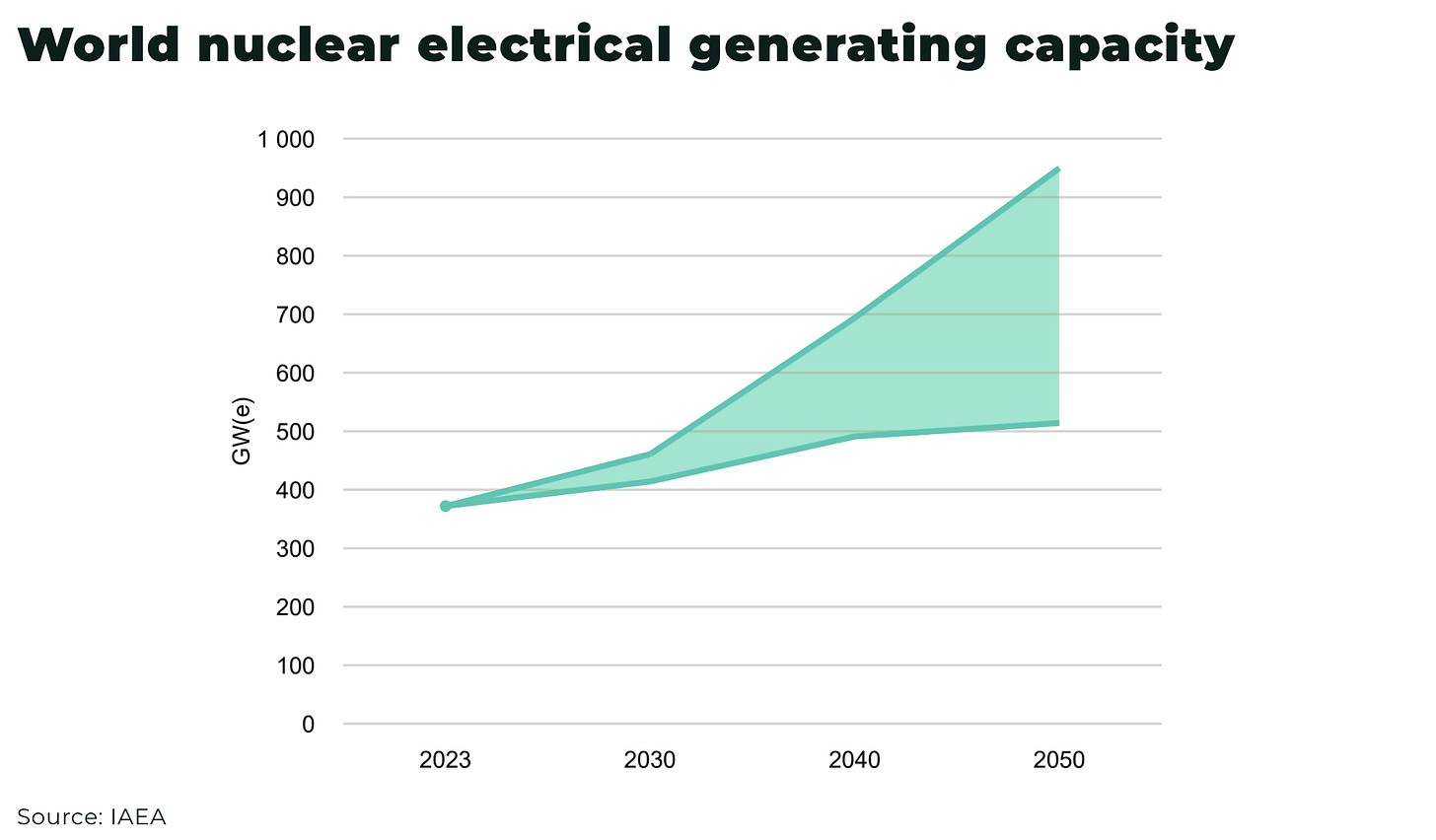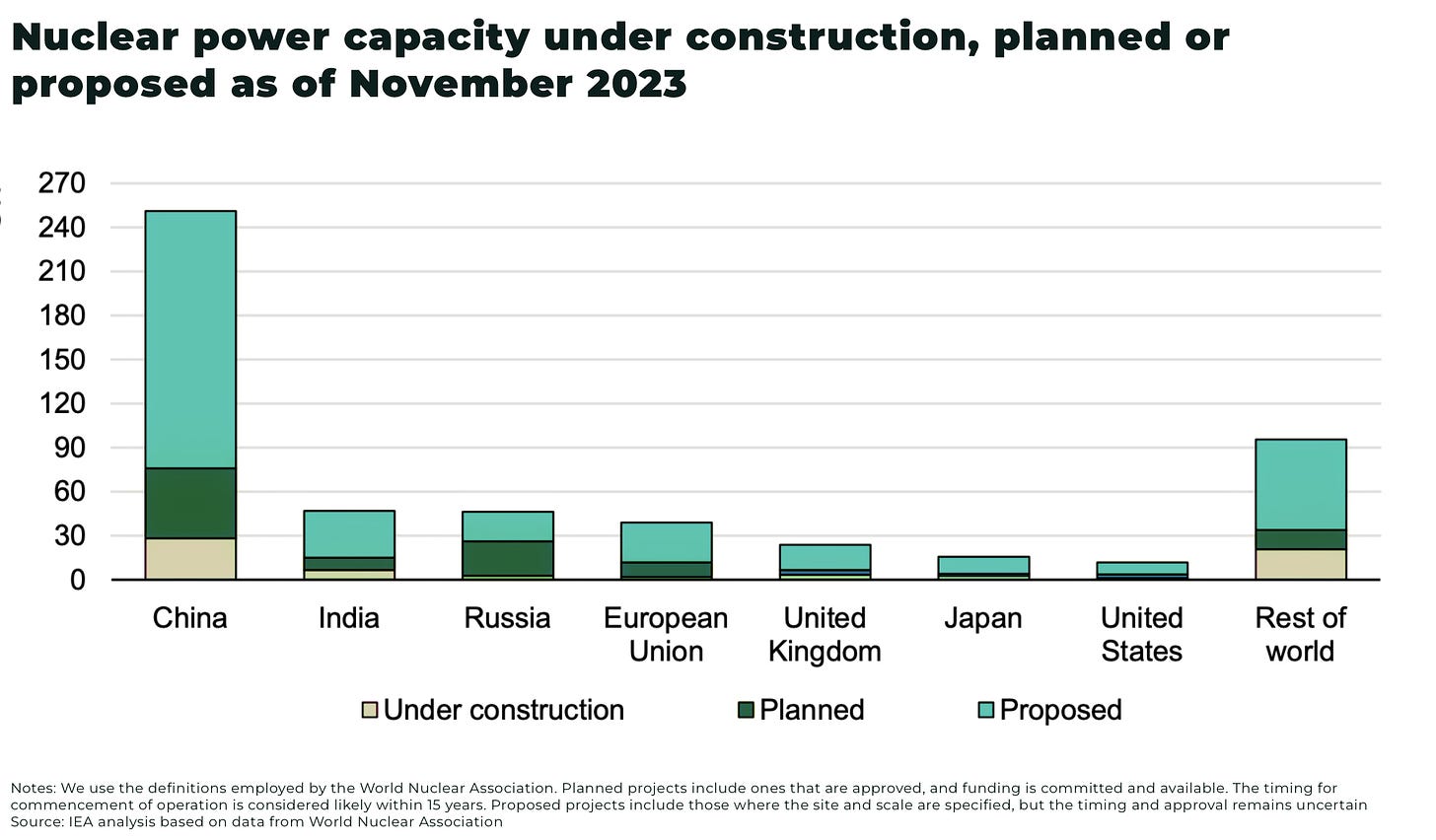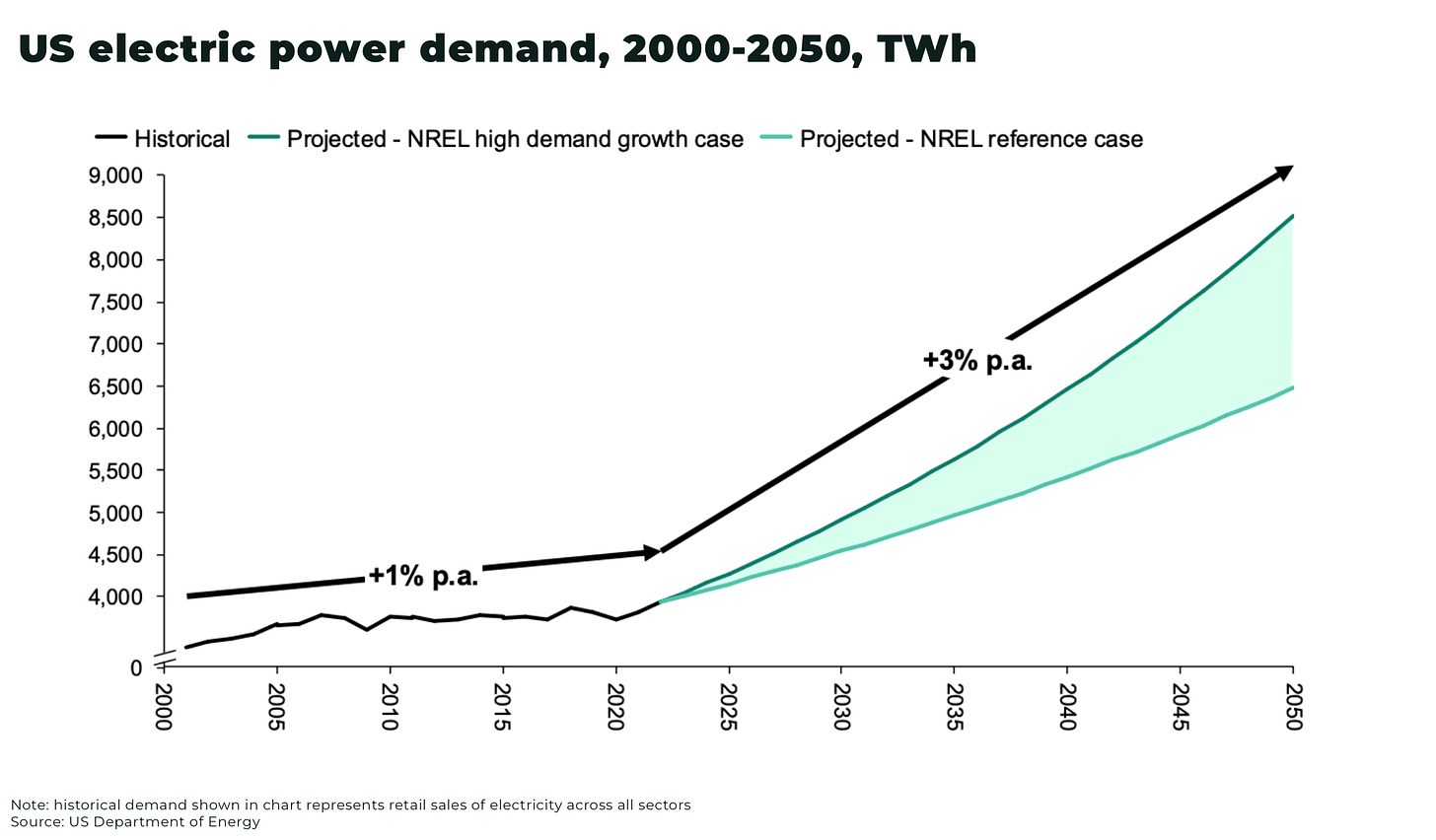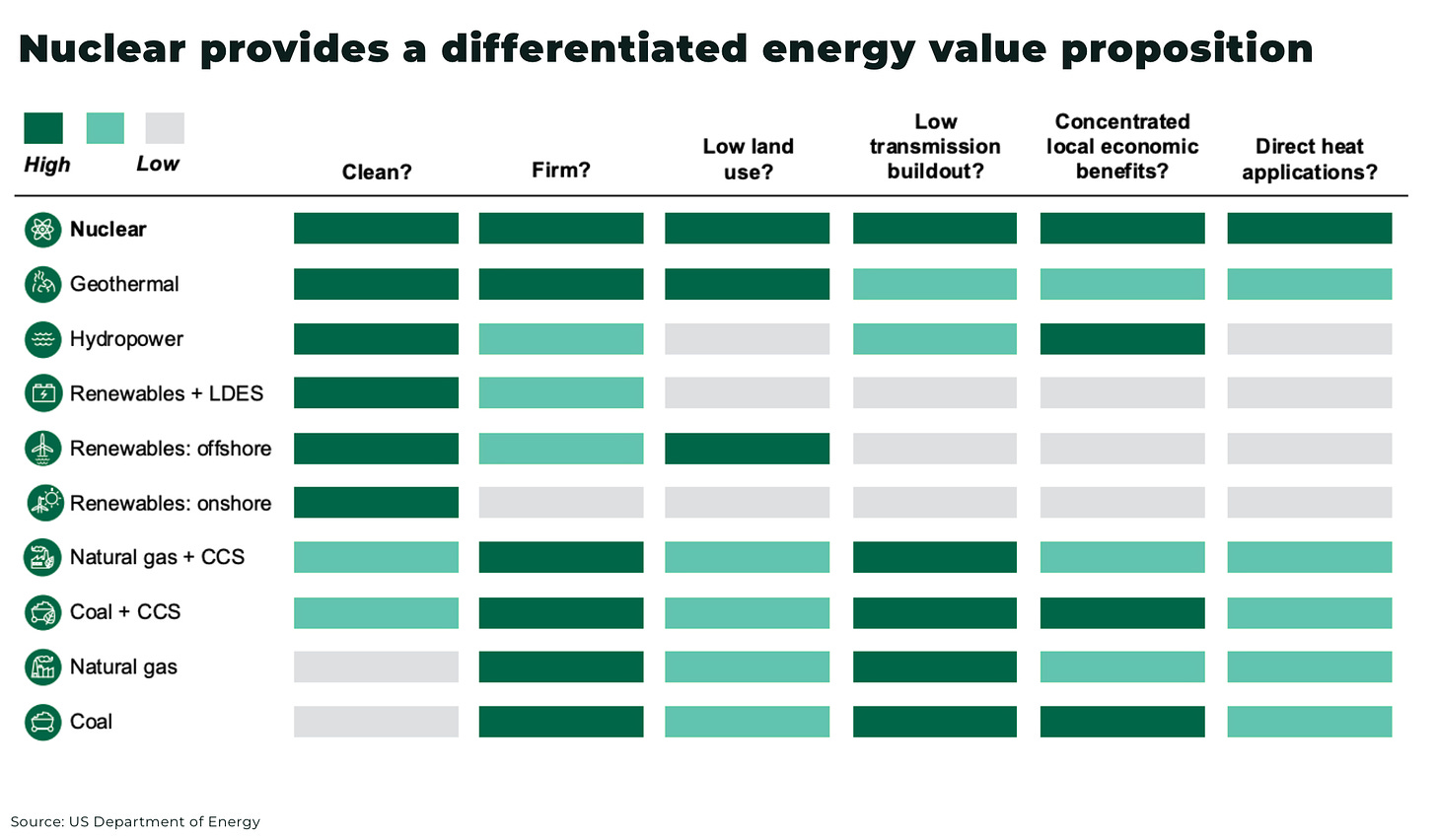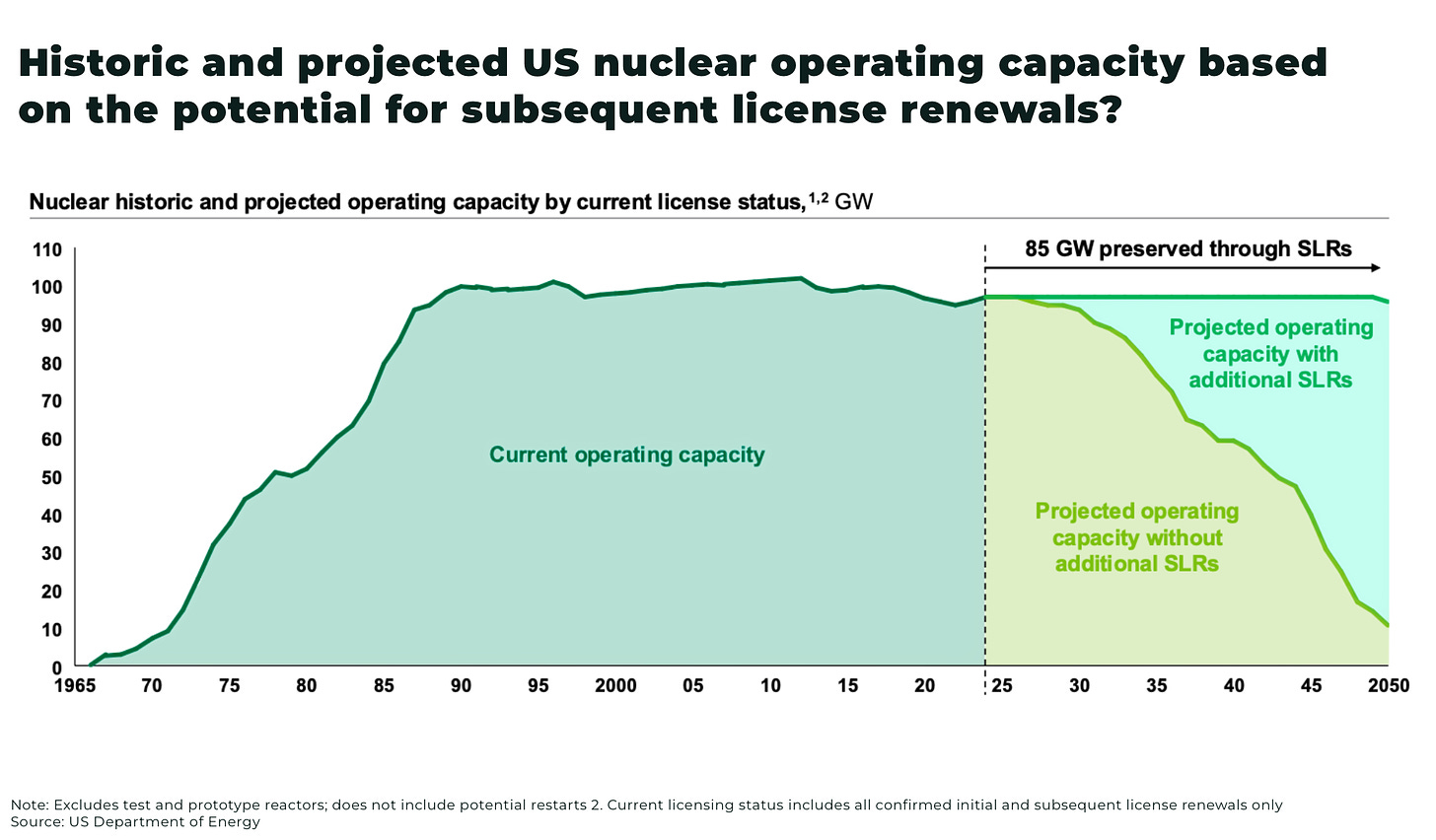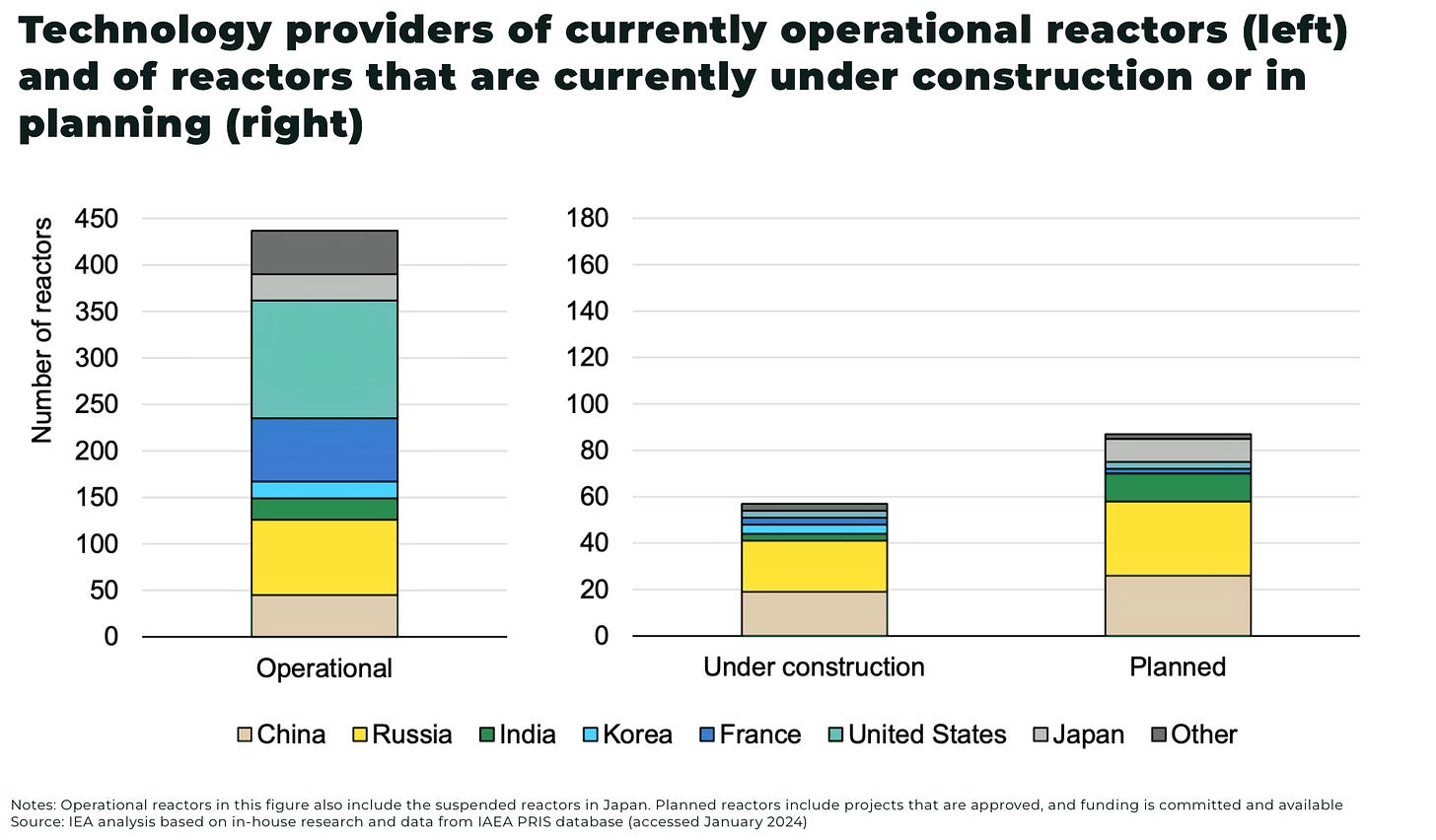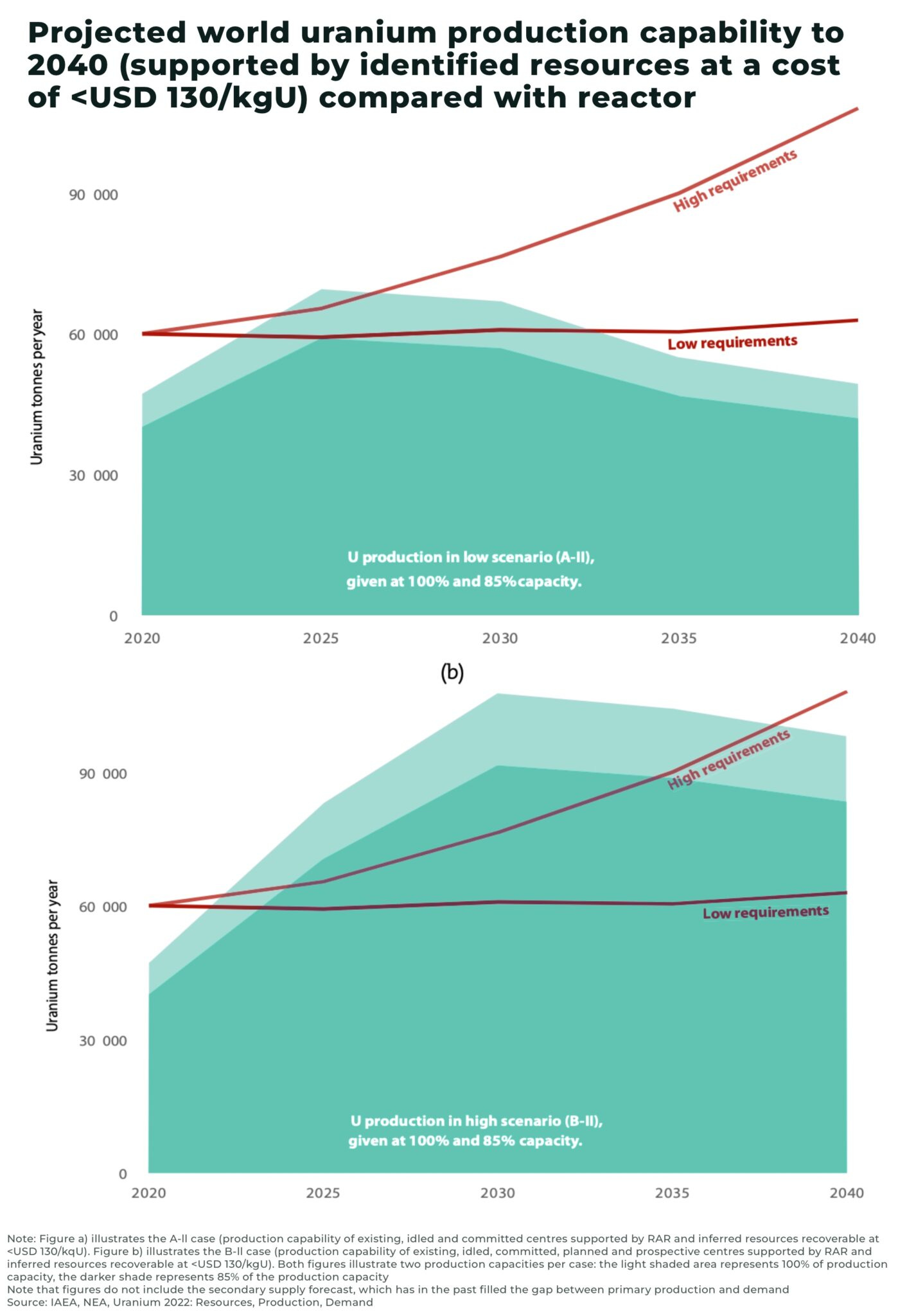Originally found on - https://theoregongroup.com/commodities/uranium/nuclear-energy-is-back/
We are experiencing an historic moment in nuclear energy.About 60 reactors are under construction across the world, and at least another 110 are planned. To put into context, there are about 440 nuclear power reactors currently operating globally.
Global nuclear generation is forecast to reach a new historical high in 2025, growing at least 3% a year.
The nuclear energy renaissance is no longer a forecast, it’s happening.
But the number of bold and broken promises over nuclear energy development over the last 30+ years is even longer — for example, 13 reactors have closed across the US in the last decade, Germany has shut down 17 reactors — so why is it any different this time?
Four main reasons:
- nuclear power station restarts and extensions
- China, in particular, is already building out a record rollout of reactors
- tech companies, financial institutions and governments pledging billions in investment
- and projects for Small Modular Reactors are being signed off and developed across the world
A new report by the US Department of Energy states US nuclear capacity needs — and has the potential to — triple from100 GW in 2024 to 300 GW by 2050.
Some of Germany’s major opposition parties are even calling for a return to nuclear power.
All of this, needless to say, will have a big impact on uranium demand.
So — and we think we can be blunt here — what the hell just happened?
The pivotal year is 2022, marked by four major catalysts:
- Russia’s invasion of Ukraine in February 24, 2022
- the Inflation Reduction Act (IRA) enacted on August 22, 2022
- the launch of ChatGPT by OpenAI on November 30, 2022
- and the lack of meaningful progress at the climate conference COP27 on November 2, 2022
- (note: a significant date preceding 2022 is March 2021, when China released its 14th Five-Year Plan, calling for a buildout of some 150 new nuclear reactors over the next 15 years)
Russia’s invasion of Ukraine caused a surge in oil and gas prices, cutting off energy supplies to Europe and creating an energy shock across global energy markets.
The Inflation Reduction Act created a production tax credit to help existing reactors stay competitive, as well as US$700 million to support the development of a domestic supply chain for high-assay low-enriched uranium (HALEU). The IRA was the starting gun on a range of financial and administrative support in the US.
The launch of ChatGPT sparked the beginning of the global race to be the world leader in Artificial Intelligence, and highlighting the critical importance of data centers. Morgan Stanley estimates global data center power will use as much energy as Spain needed to power itself in 2022. On Oct 9, 2022, NVIDIA’s stock price was worth US$11.21 — it’s now trading at more than US$118.96 due to its importance in manufacturing advanced semiconductor chips.And at COP27 governments and activists began to realise the challenge in meeting global net-zero targets by 2030. At COP28, in 2023, countries would make a declaration to triple nuclear energy capacity by 2050.
Nuclear power offers an answer to all three challenges:
- clean energy to meet net-zero goals
- stable energy offering baseload for national grids
- potentially secure energy source, not reliant on vulnerable supply chains (similar to fossil fuels)
Artificial Intelligence
The most important catalyst in nuclear energy’s momentum are the tech companies. They want energy that is clean and stable — and they have the balance sheet to pay for it.
(See our report: Artificial Intelligence and the next Critical Mineral SuperCycle)
The latest announcement that sent shockwaves across the world is a 20-year deal by Microsoft to reopen and buy energy (at a potential premium price) from the Three Mile Island nuclear plant in Pennsylvania to power its AI data centers.
“Powering industries critical to our nation’s global economic and technological competitiveness, including data centers, requires an abundance of energy that is carbon-free and reliable every hour of every day, and nuclear plants are the only energy sources that can consistently deliver on that promise”— Joe Dominguez, president and CEO, Constellation
And this is just the latest in a series of high-profile examples of tech companies turning to nuclear energy:
- Amazon Web Services (AWS) bought a 960MW data centre powered by a a nuclear power plant in Pennsylvania for US$650 million in March 2024
- Apple (finally) included nuclear power in their definition of clean energy this year
- Google’s CEO, Sundar Pichai, has said the company is looking at additional investments in nuclear, particularly SMRs to generate the electricity needed for AI
- last year, Microsoft agreed to buy nuclear power to cover 35% of the energy needs for its Virginia data centers
- the US Department of Energy has announced the closing of a loan guarantee of up to US$1.52 billion to Holtec Palisades to resume an 800-MW nuclear generating station in Michigan, as the Biden administration wants to “accelerate” discussions with tech companies over energy demands
- OpenAI CEO, Sam Altman, who chairs the boards of nuclear startups Oklo and Helion Energy, has called for data centers as large as 5GW in a recent meeting with President Biden — the equivalent of 5 nuclear reactors
- NVIDIA CEO Jenson Huang said “it’s impossible” to win the global AI race without nuclear power
- US computer tech company Oracle has “already got the building permits” for 3 small modular reactors, according to the firm’s chief technology officer Larry Ellison
In support of this, 14 global banks and financial institutions, including Goldman Sachs and Morgan Stanley, have announced their support to back efforts to triple nuclear energy by 2050.
Restarts and ExtensionsThe biggest, immediate game-changer are the nuclear power plant restarts and extensions of reactor operations.
A significant challenge with nuclear power, especially in the West, is time and cost overruns, due to planning restrictions. For example, the Vogtle Units 3 and 4 in Georgia were 7 years late and US$17 billion over budget.
Another option is extending the life of existing reactors.
Of the 94 operating US reactors, 84 have licenses that will expire prior to 2050; 24 have licenses that will expire prior to 2035. Subsequent license renewals (SLR) can extend operations from 60-80 years (and maybe longer).
Energy companies are now starting to apply for these renewals.
Global build out
The nuclear renaissance is a global phenomenon.Asia’s share in global nuclear generation is expected to reach 30% in 2026, surpassing North America as the region with the largest installed capacity.
Below we’ve listed just a small number of the new projects across the world:
- China has installed 37GW over the last decade and 27 GW currently under construction. In its 14th Five-Year Plan, China is aiming for total installed capacity of 70 GW by 2025
- Japan is in the process of restarting at least 13 reactors, and the new Industry Minister has called to “restart nuclear power, the safe one, as much as possible”
- India is planning to build 18 nuclear reactors with 13.8GW of capacity by 2032, as well as 30-50 SMRs by 2032
- France, the second-largest producer of nuclear power, may need to build more than 14 new nuclear power plants
- Canada, Ontario province has set out a significant expansion of its nuclear energy capacity, including: 3 additional small modular reactors (SMRs) and pre-development work for the first large-scale nuclear build in 30 years at the Bruce Power nuclear generating station
- UK, six companies are through to the next stage of the Small Modular Reactor (SMR) competition; and UK company Rolls Royce SMR have been selected as the preferred supplier to build in Czechia
(For more info, our report: Are nuclear small modular reactors too good to be true?)
The updates on nuclear developments appear to be endless these days.
Although, to note, it’s not all good news for nuclear power:
- Taiwan has shut down its second-to-last nuclear reactor this year
- Spain is preparing to shutter its fleet of seven nuclear power plants
- and, Germany, is still going ahead with the dismantling of its nuclear reactors and an ambition to exclude nuclear power from EU financing
What does this mean for uranium demand
If the US tripled it’s nuclear energy capacity to 300 GW, it would need access to 55,000-75,000 MT per year of uranium (U3O8) mining/milling capacity; it currently has 2,000 MT of capacity and procured 22,000 MT.And that’s just the US — global demand for uranium is expected to expand 28% by 2030 and nearly 200% by 2040.
And any new reactor requires approx 3 years worth of uranium, ordered at least 3 years prior to start up. And, supply is tightening:
- uranium production from Kazatomprom, the world’s largest uranium producer, is falling due to capacity, logistical and permitting issues (See our report: Kazatomprom, world’s largest uranium producer, flashes red)
- Australia, with the largest known uranium reserves in the world, has a series of mining moratoriums across the country’s provinces
- in Namibia, the world’s third largest uranium exporter in 2022, uranium mining is expected to slow due to water shortages
- in Niger, the military junta revoked the producer permit for one of the country’s biggest mines
We forecast uranium is at the start of a 10-year bull market.
Conclusion
The restarts and extensions of nuclear reactors has significantly accelerated the timeline for the Second Atomic Age’s arrival.
The market, in the short-term, may well be impacted by other factors, such as a possible recession affecting funding, a new US administration’s energy policies, etc.
But, in the long-term, the new momentum pushing nuclear energy cannot be turned off.
- Forums
- ASX - By Stock
- DYL
- Nuclear Energy is back!
DYL
deep yellow limited
Add to My Watchlist
0.77%
 !
$1.98
!
$1.98
Nuclear Energy is back!
Featured News
Add to My Watchlist
What is My Watchlist?
A personalised tool to help users track selected stocks. Delivering real-time notifications on price updates, announcements, and performance stats on each to help make informed investment decisions.
 (20min delay) (20min delay)
|
|||||
|
Last
$1.98 |
Change
0.015(0.77%) |
Mkt cap ! $1.921B | |||
| Open | High | Low | Value | Volume |
| $1.93 | $2.00 | $1.92 | $9.979M | 5.049M |
Buyers (Bids)
| No. | Vol. | Price($) |
|---|---|---|
| 2 | 31810 | $1.98 |
Sellers (Offers)
| Price($) | Vol. | No. |
|---|---|---|
| $1.98 | 30190 | 1 |
View Market Depth
| No. | Vol. | Price($) |
|---|---|---|
| 2 | 31810 | 1.975 |
| 2 | 11493 | 1.970 |
| 1 | 1496 | 1.965 |
| 1 | 4000 | 1.960 |
| 1 | 3500 | 1.920 |
| Price($) | Vol. | No. |
|---|---|---|
| 1.980 | 30190 | 1 |
| 1.995 | 53069 | 6 |
| 2.000 | 302246 | 29 |
| 2.010 | 259619 | 4 |
| 2.020 | 14495 | 3 |
| Last trade - 16.10pm 09/09/2025 (20 minute delay) ? |
Featured News
| DYL (ASX) Chart |
